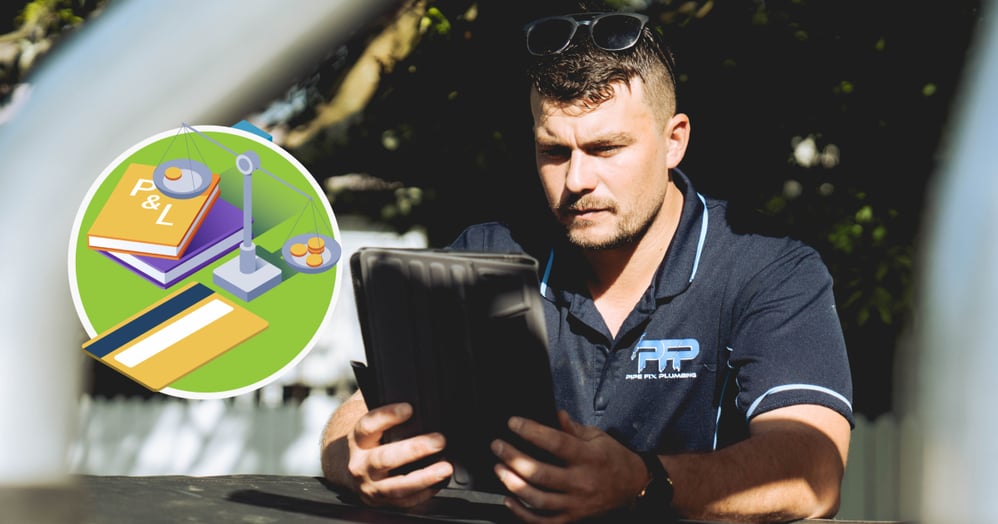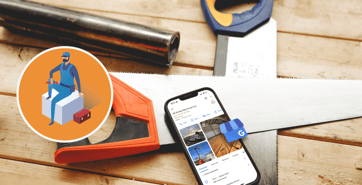Your Guide to Plumbing Business Expenses & Start-Up Costs
by Team Tradify, April 20, 2023

Table of Contents
Starting your own plumbing business costs an average of around 5000 USD, depending on where you live, how far you want to take your marketing practices, and the quality of tools, materials, vehicles, and insurance that you plan to invest in. Before you pull together your business plan, brainstorm a catchy business name, or think about hiring staff, make sure you’ve got these six plumbing business start-up costs covered:
Find your perfect hourly rate with our free Charge Out Rate Calculator!
Short on time? Skip ahead!
- 1. Tools
- 2. Stock & inventory
- 3. Insurance
- 4. Transport
- 5. Marketing & advertising
- 6. Making it official
- 7. Tradify job management software
1. Tools
One of the first costs to consider when starting a plumbing business is the tools. And we’re not just talking about what’s going in your tool bag — digital tools are just as important. Here’s what you need to consider and how much it’ll cost you:
Digital tools
If you’re wondering how on earth you’re going to manage your finances while you’re already busy enough behind the tools, we have some good news for you. There’s plenty of amazing bookkeeping software out there that’s affordable for small, up-and-coming businesses. It’s the best way to manage cash flow, ensure your invoices are delivered and paid on time, and avoid major admin headaches when tax time rolls around. It’s also much more affordable than hiring an accountant.
On the subject of software, combining your accounting software with job management software like Tradify makes it easy to keep all your notes, quotes, and documents in one place. It also allows you to whip up professional-looking estimates on the spot, and will even automatically chase up overdue payments for you.
Ballpark annual subscription costs for job management and accounting software at the time of writing:
- 🇬🇧 UK — £500-600
- 🇺🇸 USA — $700-800
- 🇦🇺 AU — $600-700
- 🇳🇿 NZ — $600-700
Plumbing tools & gear
A solid collection of high-quality tools and gear will likely be one of your highest upfront costs. While you may be tempted to go for the cheaper options at this stage and buy budget equipment, it’ll only cost you more in the long run as you have to replace broken tools or gear. While the exact equipment you’ll need can vary, at a bare minimum, you’ll need:
- Essential plumbing tools like a pipe-cutter, press tool, and a good range of power tools.
- A sturdy, well-constructed plumber’s tool bag to keep your precious gear in one place.
- High-quality plumber’s workwear and PPE.
Ballpark equipment costs at the time of writing:
- 🇺🇸 USA — $745-1400
- 🇬🇧 UK — £600-1100
- 🇦🇺 AU — $1,100-2,000
- 🇳🇿 NZ — $1,200-2,200
Remember, tools are considered business assets because they add to the value of your business. Here’s how business expense claims work, by country:
- 🇺🇸 USA business tax write-offs
- 🇬🇧 UK business expense claims
- 🇦🇺 Australian business expense claims
- 🇳🇿 NZ business expense claims
2. Stock and inventory
Customers don’t like delays and for a new business, it’s important to keep the ball rolling and the momentum in your favour. That’s why it pays not to leave your jobs up to the supply gods — we already know how greatly shortages are affecting tradespeople.
The best way to avoid the impact of shortages is to keep stock and inventory on hand, especially leading up to Christmas and holiday rush periods. Things like piping, taps, tape, and extra tools are all things to consider stocking up on.
Research which brands other plumbers use, compare prices of different suppliers and ask about plumbing deals, discounts or loyalty programs.
Don’t forget to consider components and materials when calculating your profit margin.
3. Insurance
If you’re entering the plumbing industry as a business owner, it’s important to keep health & safety at the top of your mind. While the most important thing is to stay safe from risks and hazards, from a business perspective, it’s also important to be insured.
Insuring your tools is also important. This’ll keep you covered if your tools are broken, lost, or even stolen.
In some cases, you’ll have to be insured by law, so check out our business insurance guide to see the requirements in your country.
The main plumbing business insurance plans you might need are:
- Public liability insurance — covers you if your company causes injury or property damage. If a claim is successful, the insurance will pay out.
- Tools and equipment cover — plumbers need their tools, so make sure you’re protected against loss or damage.
- Income protection — will kick in if you get sick or injured and can’t work for a while.
- Employer’s liability insurance — if you hire employees or take an apprentice under your wing, you need specific insurance to cover them.
- Vehicle insurance — your work vehicle must also be insured under your business.
Insurance costs vary from region to region, between insurance companies and between customers – your best first step is to sit down with an authorised business insurance broker.
4. Transport
A work vehicle is one of the most important investments any plumbing business owner can make when starting up. Not only does it need to be reliable enough to get you from job A to job B without a hitch, but it also needs to function as an office on wheels.
With plenty of financing options available to lighten the load of such a large purchase, buying a new ride doesn’t necessarily have to be a burden. Ballpark used vs new vehicle costs at the time of writing are:
- 🇺🇸 USA — $4,000-40,000
- 🇬🇧 UK — £4,000-35,000
- 🇦🇺 AU — $8,000-60,000
- 🇳🇿 NZ — $8,000-60,000
Stuck on the new versus used conundrum? This new vs second-hand guide will help you pick what’s right for your business.
Price aside, here’s what else you should consider when choosing a ride:
- Good signage can generate new business, so make sure you’ve got it nailed with an eye-catching wrap design.
- Your vehicle is often what clients will see first, so make a good impression. Your car should be clean, tidy, and well-behaved on the roads.
- It can impact your productivity – make sure it’s fitted with plenty of internal storage, a roof rack for long objects like ladders, and non-slip rubber mats to avoid accidents.
5. Marketing & advertising
If you’ve been a pro plumber for a while, then you may have already built a respectable roster of loyal customers. Regardless of if that’s the case, you still need to market and advertise your operation — it’s how most businesses grow these days. So, start by creating a solid plumbing business marketing plan and focus on the following:
- Building your brand — Get creative on Canva or find freelancers on Fiverr to create some graphic designs for your website, uniforms, vehicle wraps, business cards, invoices, and quotes.
- Creating a digital presence — If you haven’t already, get on social media and create a website — there’s no better way to get your name out there these days. Also, be sure to take advantage of customer reviews to win new business. And remember… never stop taking photos of the great work you’ve been doing!
These ideas are free or relatively low cost, making them a great place to start. Once you’re more established and turning a profit, you can expect to spend 2-5% of your gross annual revenue on marketing and advertising.
For more digital marketing tips, read our guide to digital marketing for small businesses and tradespeople.
6. Making it official
Not just anyone can start a plumbing business. In most countries, you’ll have to prove that you’re skilled enough to provide proper plumbing services. This means acquiring the necessary licences, permits, and certifications. Check local council and government websites to see what’s required.
You’ll also need to register your business name. Use our plumbing business name generator or pick a name yourself that’s professional, unique, easily remembered and not already taken. This is a crucial (and exciting!) step towards setting your plumbing business up for tax requirements, opening a bank account and becoming an official business owner.
The ballpark costs for registering your business at the time of writing are:
- 🇺🇸 USA — $100-800
- 🇬🇧 UK — £12-40
- 🇦🇺 AU — $440-530
- 🇳🇿 NZ — $115
It pays not to skip these steps — avoiding them could land you a hefty fine.
7. Time is money, so don’t let it cost you
Going out on your own can be daunting, but a solid understanding of basic plumbing business start-up costs allows you to proceed with confidence. It’ll help you decide between the must-haves and the nice-to-haves and prioritise expenses that will contribute to long-term success.
Don’t spend your time hunched over a pile of paperwork when there are perfectly good job management solutions out there. Tradfy will cut hours off your admin and give your business every opportunity to succeed.
Try Tradify for free, or pop over to one of our live demo webinars to see it in action.
Please note: this article is a basic overview of plumbing business start-up costs & expenses and is not intended to be financial advice.
Related articles

How To Set Up a Google Business Profile (for Trade Businesses)

Aussie Electrician Reduces Admin Time by 95%

Squeaky Clean Scheduling for Pro Carpet Cleaning
Give Tradify a go for free!
Save 10+ hours/week on business admin with the highest-rated job management software for tradespeople.
With free one-on-one training and phone support, it's never been easier to get started.






